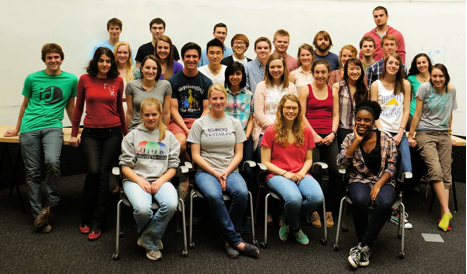
Caption: The 2013 Virginia Tech sophomore Industrial Design class
In 2010, the Wireless RERC began offering industrial design students an opportunity to participate in a brief project to explore application of Principles of Universal Design to mobile wireless technologies. Faculty of the ID programs of Georgia Institute of Technology (Georgia Tech) and Virginia Polytechnic Institute and State University (Virginia Tech) have embraced the challenge and incorporated this project in their spring curricula ever since.
Students who have participated in the project have noted that universal design is not only “the right thing to do”, but an important ingredient to their success as professional designers. Experts in industry and design have agreed. Student work in this project has received international recognition, including a first-place award for a Virginia Tech team in LG’s “Design the Future” competition and selection of a Georgia Tech team for a Social Design Award from the Victor J. Papanek Foundation.
Our largest class to date
During the 2013 spring semester, 80 industrial design students at Georgia Tech and Virginia Tech participated in the Wireless RERC’s fourth annual “Getting Wireless” design challenge. This year, 32 sophomores at Virginia Tech participated under the direction of Professor Mitzi Vernon and Assistant Professor Akshay Sharma. At Georgia Tech, 15 juniors under instructor Wendell Wilson, and 33 sophomores under Assistant Professor Young Mi Choi and instructor John Lau participated in the project.
The assignment
In each class, teams of 3-4 students were assigned one of four customer personas based on data collected through the Wireless RERC’s Survey of User Needs (SUN):
- “Mary”, a cellphone user with limited vision, 85 years of age
- “Jack”, a farmer with chronic cardiopulmonary conditions and limited literacy, 68 years of age
- “Michael”, a student with hearing and mental limitations resulting from a car accident, 16 years of age
- “Dana”, an army veteran with limited balance and no use of her dominant arm, 24 years of age
Each persona presented students with a real-life scenario based on use of wireless technology. T-Mobile provided HTC MyTouch smartphones for each team. These devices served as a common starting point for developing design strategies to meet the needs of their persona, while also considering the impact of these strategies on the other personas and on wireless customers without disabilities. “Evaluating the Universal Design Performance of Products”, a tool developed by the Center for Universal Design at North Carolina State University, was used in assessing students’ universal design approaches. Students were encouraged to refer to this guide throughout their design process.
Team presentations
At the conclusion of the project, each student team presented their 3D study model and described their research and strategy to meet the needs of their persona and the impact of these strategies on the other wireless customers with and without disabilities. Wireless RERC staff offered feedback to each team during the project and at these presentations.
North Carolina State University’s Department of Graphic Design and Industrial Design under Professor Tsai Lu Liu hosted the Virginia Tech teams as they presented 5-minute videos of their work at the Industrial Designers Society of America (IDSA) Southern District Conference on April 6. These videos, as well as posters by the GA Tech junior teams, were also featured at the 2013 Healthy Environments and Active Lifestyles Open House at Georgia Tech on April 23.
Students’ opinions
As in previous years, students participating in the “Getting Wireless” design challenge were surveyed about their opinions concerning universal design at the start and conclusion of the project. Most felt that a universal/inclusive approach to design is not only the “right thing to do”, but will also help them in their careers. All agreed that considering elders and people with disabilities improves the usability of design for everyone.
The 2013 class impressed the Wireless RERC staff with thorough and insightful research regarding their personas, as well as understanding of available and emerging technologies to meet their needs. Despite the limited duration of the project, each team enthusiastically explored a broad range of creative concepts. Their polished final presentations reflected understanding of the issues involved in applying universal design principles to real-life challenges. All of us who use wireless technologies, with and without disabilities, will benefit when these students pursue career opportunities in the wireless industry.
Thanks!
The Wireless RERC extends thanks to all the students participating in the 2013 “Getting Wireless” challenge, and to their professors, who devoted additional time and effort to make this project so meaningful to them:
Virginia Tech Team Solutions
- Virginia Tech “Dana” Team Solution – Activ
- Virginia Tech “Michael” Team Solution - BuzzMe™ & BuzzBand™
- Virginia Tech “Jack” Team Solution – Life Track
- Virginia Tech “Mary” Team Solution – Link
- Virginia Tech “Jack” Team Solution – Health on TracK
- Virginia Tech “Mary” Team Solution – Matchvox
- Virginia Tech “Michael” Team Solution – NuWave
- Virginia Tech “Dana” Team Solution – UNIFI







